Author's Posts
.webp)
How to Stop Financial Chaos in 1 Month. Case Study of a Logistics Company
One month — and financial uncertainty transforms into a system. Set up an accounting system that works.
Most entrepreneurs will understand this point: it seems that the company is growing, the number of customers is increasing, the team is expanding — but the numbers don't add up.
There is money in the accounts and in the cash register, but still, something is constantly "off."
Someone is to blame, someone has paid, someone hasn't, and most importantly, it's unclear where your business stands financially.
This is what happened to Vadym, the founder of Atlant Company LLC, which operates in the field of logistics and transportation services.
As the company grew, the finances remained "in the head" of the owner. And when the scale began to require a system, Excel was no longer enough.
Work is going on, but there is no understanding — is there money, where is it, who owes me, do I owe anyone.
Basically, it was chaos. — Vadym, owner of Atlant Company LLC
What You Will Learn from This Case Study:
- You will see what a typical small business financial crisis looks like from the inside.
- You will learn how the owner of a logistics company put his finances in order in a month without an accountant.
- You will understand how Finmap really changes an entrepreneur's mindset.
- You will receive practical advice that will help you avoid financial blindness in your own company.
This case study is a roadmap for every entrepreneur who sees cash flow every day but does not see financial results. Because control over money is control over the future of the business.
About the Client: When Logistics Becomes Large-Scale and Finances Become Unmanageable
Atlant Company LLC is a logistics company specializing in the transportation of grain crops and agricultural products for farms, elevators, and traders.
The company operates in the B2B segment, where speed, reliability, and cash flow are key success factors.
During peak season, there are dozens of trips at the same time: grain is on the road, drivers receive advances for fuel, customers pay after delivery, and part of the costs must be covered in advance.
It seems like chaos, where even a single mistake in finances can cost a month's profit.
Before that, I kept track of everything in simple spreadsheets that I made myself. Income, expenses — simple formulas: add, subtract, multiply. — Vadym, owner of Atlant Company LLC
For years, the company lived in Excel. As long as the volume of transportation was small, it worked.
But when the team grew and the number of customers exceeded a dozen, Excel turned from an assistant into a trap.
The owner could only see fragments: fuel costs separately, customer receipts separately, debts to suppliers separately. But there was no complete picture of the cash flow.
A Peculiarity of the Industry: High Turnover — Low Financial Transparency
In grain logistics, money is constantly moving. There is rarely a "stable" picture here, because:
- expenses occur daily (fuel, repairs, salaries);
- payments from customers are delayed;
- each trip is a separate mini-project with its own balance sheet.
Without an accounting system, it looks like this:
- the accounts are in the red, but there are still 10 customer payments on the way;
- debts to drivers are not synchronized with actual receipts;
- financial decisions are made based on "gut feelings."
The business is growing, the number of people has increased — all this needs to be organized. — Vadym, owner of Atlant Company LLC
Conclusions for Entrepreneurs:
- If your business has grown to 5+ people or 10+ customers, Excel no longer works.
The risk of error increases exponentially, and control disappears. - In logistics, the most important thing is to see the cash flow in real time.
Not just "profit for the month," but "what's in the accounts right now." - A financial system is not about expenses, but about security.
Without it, even a profitable business can "break down" due to invisible cash gaps. It frees the owner from daily control and returns him to the role of strategic manager.
Problem: When the Business Looks Stable, but the Numbers Don't Confirm It
At first glance, everything was under control at Atlant Company LLC. Trucks were on the road, customers were satisfied, contracts were signed, and there was constant movement in the accounts.
The company was operating and growing, but every time Vadym attempted to answer the simple question, "How much have we actually earned?", a quest would commence.
This is a typical paradox of operational business: when processes appear to be organized, but finances live a separate life. The more flights and customers there are, the more difficult it is to understand where the money is "stuck."
It was this problem that made Vadym realize that without an accounting system, finances turn from a resource into a risk.
Insight for entrepreneurs: Financial chaos does not begin when there is a shortage of money.
It begins when there are too many points of circulation and no one can see the whole picture.
1. The Money Was There — but It Was Unclear Where
The main financial problem of the business was lost visibility. The company worked with several accounts, cash transactions, and drivers who accepted payments on the road. And every day there were dozens of small transactions: fuel, repairs, small purchases.
It seemed like the money was "circulating," but it was almost impossible to balance the books even at the end of the week.
The money is there somewhere, but I don't understand where exactly: in the cash register or in the accounts. The tables show nothing. — Vadym, owner of Atlant Company LLC
When the financial system is scattered between cash, accounts, tables, and people, it's not accounting, it's financial chaos.
2. Uncontrolled Accounts Receivable — the Hidden Enemy of Profit
The second headache is customer debt. Logistics companies often work with deferred payments, especially in grain transportation. One customer pays in a week, another in a month, and a third "when they sell the grain."
Vadym tried to keep track of debts in his own Excel spreadsheets, but quickly realized that this was impossible to scale. The result is a constant "sag" in cash flow: customers owe money, but there is still not enough money in the account.
Accounts receivable is not just "who owes me." It is the pulse of a company's liquidity. Without control over debts, even a profitable business can come to a halt due to a cash flow gap.
3. Excel Can't Keep Up with Logistics
Excel is a good start, but a poor foundation. What works for three payments a day breaks down at thirty.
Finances in Excel only worked as long as the owner could keep everything in their head.
When drivers, managers, and several directions appeared, the tables stopped working.
A mistake in a formula, a missed row, or an incorrect date — and the financial picture is distorted. And there is no time to check.
Excel is a great tool for analysis, but disastrous for financial management. Because management is not about "counting backwards," but about seeing the situation now.
4. The Owner Became an Accountant — and Ceased to Be a Strategist
When a business owner acts as an accountant, analyst, and cashier at the same time, the company stops moving strategically.
Instead of planning for development, Vadym spent every day trying to "make ends meet":
- manually updating tables;
- monitoring payments;
- checking who had paid and who had not.
This created constant stress and fatigue.
When financial accounting depends on just one person, you're not running a business — you're a hostage to your own data.
5. Intuitive Decisions — No Numbers, No Forecasts
Without an analytics system, Vadym made decisions "by eye." If it seemed that there was enough money, they bought fuel and took a new route. If not, they delayed payments to suppliers.
If you can't see the dynamics of cash flows for at least a month, you're not managing finances, you're just reacting to problems.
Final Diagnosis of Atlant Company's Financial Problems
Why These Problems Are Familiar to Every Entrepreneur
Vadym's story is not unique. This is how 90% of small and medium-sized businesses in Ukraine look, especially in operational areas: logistics, trade, services, and manufacturing.
They all have turnover, teams, and customers — but they don't have a financial system.
And as long as the company does not have Finmap or a similar tool, every hryvnia in the business is approximate.
Searching for a Solution and Getting to Know Finmap
I contacted companies that implement CRM, but they couldn't get my work up and running. I had been looking at Finmap for a long time and tried it out. You are the best in Ukraine. — Vadym, owner of Atlant Company LLC
After several months of sleepless nights spent working on Excel spreadsheets, Vadym realized that the problem was not in the formulas, but in the lack of a system that thinks like a business.
1. A Year in Search of the "Perfect System"
Vadym's path to Finmap was long. Like most small business owners, he went through the classic evolution:
- Stage 1 — Excel: "I'll make a simple table myself" → Works until dozens of transactions appear.
- Stage 2 — CRM: "I need a program that will connect everything" → But CRM is focused on sales, not money.
- Stage 3 — Custom development: "They'll make a system for me" → High price, long launch, and still no analytics.
Many business owners are looking for a "magic program." But financial transparency does not come from a system — it comes from a mindset that Finmap helps to build.
2. How Vadym Chose Finmap
Vadym had heard about Finmap long before working with them. He just "wasn't ready then."
As is often the case with many entrepreneurs, the decision didn't come on the first try. At some point, Excel finally stopped working, and managers began to "drown" in the chaos of transactions. Then he returned to Finmap — this time with a specific request: "I want to see where the money is in real time."
3. Why Finmap Became "The Right Solution"
After testing several alternatives, Finmap turned out to be the only system that:
Finmap is not a program "for accountants." It is a tool for owners who want to understand what is happening with their business's money here and now.
4. First Impressions of the System
After the initial setup, Vadym felt the main thing — control was back.
The ability to add people, create cash registers and card accounts, and see everything on one screen is very convenient. — Vadym, owner of Atlant Company LLC
His finances ceased to be "spreadsheets" and became a living picture of the movement of funds.
The first results in Finmap are visible in just a few days. When you see all your accounts, receivables, and expenses on one screen for the first time, it's a moment of financial clarity.
Why Finmap Won
A financial system does not appear overnight. First, there is a realization that chaos no longer works. Then comes a solution that allows this chaos to be tamed.
For Vadym, that solution was Finmap — not just a service, but a partner that helped turn money from a pain point into a tool for growth.
Finmap's Express Solution: When Finances Become a System, not a Headache
The Finmap financial expert understood exactly what I wanted and helped me by explaining the best course of action for my specific situation. — Vadym, owner of Atlant Company LLC
When Vadym chose Finmap, he didn't just sign up for a new service. He launched a process of business transformation — from chaos to structure. The express setup format means that in just 3–4 weeks, the company goes from "everything in spreadsheets" to a full-fledged management accounting system.
1. Start: Reality Audit
The first step is to understand what is happening now.
Finmap's financial expert began by analyzing Atlant Company's existing spreadsheets, payments, and processes.
Yulia explained what was needed at this stage. Everything was as accessible as possible. I understood what to do and when to do it. — Vadym, owner of Atlant Company LLC
The task at this stage was to transform "chaotic accounting" into a clear structure of flows: income, expenses, accounts, cash registers, and counterparties.
Insight: You can't automate chaos. First, you need to see where the chaos is, and only then implement the system.
2. Building a Structure in Finmap
After the audit, Finmap's financial expert helped Vadym set up the company's financial architecture: they created accounts, cash registers, expense and income categories, connected cards, and added counterparties.
For a logistics company with dozens of payments every day, it is important that all accounts are "under one roof." Finmap allowed them to see the full picture of cash flow in real time — without manual reporting.
Insight: The financial system should not only work "for the owner." The team must understand it — and that is what allows the business to scale.
3. Training and Mentoring: When a Financier Becomes a Mentor
The financial expert explained everything in an accessible way, without using complicated words. If I had any questions, I wrote them in the chat and got an immediate response. It was all very simple. — Vadym, owner of Atlant Company LLC
After the technical setup, the main stage began — the educational one.
Yulia didn't just show us "where to click," she explained the logic behind management accounting:
- how to properly separate personal and business funds;
- why it is important to plan account balances;
- how to read a P&L statement, even if you are not an accountant;
- how to use categories for financial analysis.
The format of the work is completely online, but with the effect of personal presence.
I provided access to Finmap, the financial expert saw what I was doing, and then said, "This is good, but here I would do it differently." — Vadym, owner of Atlant Company LLC
Insight: Finmap doesn't just provide a tool. It teaches financial thinking — a skill that most entrepreneurs lack.
4. Results After Implementation
Within a month, Atlant Company had completely transitioned to the new system. All income, expenses, accounts, and debts are now displayed in a single interface. For the first time, the company has achieved complete transparency of cash flows.
I understand that I should have a certain amount of money. I look — it's not enough. We check and immediately find where it went. — Vadym, owner of Atlant Company LLC
Insight: The result of implementation is not just "filled tables." It is the moment when the business sees itself in numbers for the first time — honestly, objectively, without assumptions.
5. The Human Factor: Support and Interaction
Everything is just as it should be. The information is clear, communication is easy. And most importantly, you can feel that people care. — Vadym, owner of Atlant Company LLC
One of the key factors for success is the approach of Finmap experts. Each client is assigned a personal specialist who understands not only finance but also the context of the business.
In Vadym's case, this means agricultural logistics, specific payments, mutual settlements with drivers, and seasonality. The financial expert adapted each step specifically to these processes — without offering "general advice."
A financial system is only effective when it is implemented with the realities of the business in mind.
6. How Vadym's Financial Thinking Has Changed
After the express setup, Vadym recognized that Finmap's main value lies not only in data, but also in peace of mind.
Implementation is more difficult than maintenance. But once everything is set up, maintenance is no problem at all. — Vadym, owner of Atlant Company LLC
He used to check Excel at night to make sure he didn't forget anything. Now he opens Finmap in the morning to see the real picture.
Insight: Financial setup is not a technical process. It is a transition to another level of management, where business operates based on data rather than intuition.
A Brief Summary of the Stages of Express Setup
Key insight of the section: Financial automation is not "just setting up software." It is a process that turns chaos into a system and the owner into a financially conscious manager.
Results and Insights: When Money Stops Disappearing
Only a month has passed since the express implementation of Finmap, and the changes were immediately noticeable. And it's not just about the convenience of the system — it's about a change in financial thinking. What used to be "assumptions" became clear numbers. And what seemed to be a "time problem" turned out to be a problem of lack of structure.
1. Complete Visibility of Cash Flow
Before Finmap, Vadym's finances existed in three dimensions: in his head, in spreadsheets, and in banking apps. Now everything is in one place.
Being able to view accounts, cash registers, and card accounts on one screen is much better. Everything is visible at once. — Vadym, owner of Atlant Company LLC
As long as money is scattered across spreadsheets and accounts, it's not a system, it's a chaotic flow.
Finmap brings everything together on one screen, where you can see what's really happening with your business.
2. Accounts Receivable Are No Longer a "Black Hole"
Before Finmap was implemented, accounts receivable existed "in the head" of the owner. There were many customers, dozens of payments, and everyone promised to "pay tomorrow."
The system made it possible to turn this invisibility into a concrete number. Accounts receivable is not just a table of debts. It is a barometer of business stability.
As soon as you start seeing accounts receivable, you start managing money instead of waiting for it.
3. Time Savings and Peace of Mind
Before Finmap, Vadym spent several hours each week on reconciliations, manual calculations, and clarifications. Now, financial control takes 15–20 minutes a day.
When financial anxiety disappears, energy for development appears.
Finmap frees up not just time — it frees up your mind.
4. A New Culture of Decision-Making
After implementing Finmap, decisions at Atlant Company began to be made based on data rather than feelings.
You will see results if you do everything correctly for a month. Then you can see where the expenses are and where the profits are. — Vadym, owner of Atlant Company LLC
Previously, it seemed like we were making money. Now, we know exactly which areas are profitable and which are losing money.
A financial system is not just a way to control expenses. It is a compass for decision-making that reduces risks and increases profits.
5. Financial Confidence
After all the technical and organizational changes, Vadym says that the most important result is emotional peace of mind.
Previously, everything was chaotic, but now I understand what is happening. And that is already a big step forward. — Vadym, owner of Atlant Company LLC
The company didn't just put its finances in order — it created a financial culture.
Managers see their part, the owner sees the big picture, and money is under control.
Financial transparency is not about numbers. It's about a sense of control and freedom.
You have a good product. I like you. As of now, everything is in order. — Vadym, owner of Atlant Company LLC
Vadym's results are proof that even in a complex logistics business, it is possible to bring financial order in a month.
Finmap didn't just automate the numbers — it gave the entrepreneur back what is most valuable: clarity, control, and peace of mind.
When the owner stops "counting manually" and begins to see the system, his business transforms from a craft business into a managed one. And that is the moment when real growth begins.
Frequently Asked Questions
1. Why can financial chaos arise in a business, even if there are many customers and orders?
As a company grows, the number of transactions, people, and payments increases, and it becomes more and more difficult to control money "by feel." Expenses and revenues are scattered across spreadsheets, chats, banking apps, and the memories of individuals. Without a unified accounting system, financial data ceases to be transparent, and the owner loses sight of the real picture.
2. Why does Excel stop working at a certain stage?
Excel is great for analysis, but not for managing finances in daily operations. Errors in formulas, missing entries, duplicate files, and lack of synchronization with the bank make accounting unreliable. When there are dozens of transactions per day, the spreadsheet cannot keep up with the business. The company begins to operate in a state of "we kind of understand what's going on" — and that's dangerous.
3. What are the practical benefits of implementing Finmap?
Finmap brings all financial flows together in one place: accounts, cash registers, expenses, receipts, and debts. The system automates accounting, generates reports, and shows the real state of money at any given moment. The owner no longer spends hours on reconciliation and can make decisions based on accurate data — not intuition.
4. Do you need an accountant to work with Finmap?
No. Finmap is designed for business owners and operations managers. The interface is simple and intuitive, and during the setup process, a Finmap expert teaches you how to think about finances, not just "where to click." At the same time, if necessary, an accountant can also have separate access.
5. How long does it take to get your finances in order?
You will see results in just a few days — when all accounts, cash registers, and cash flows are collected in one place. A full express setup takes 3-4 weeks, after which the business will have systematic financial accounting, accounts receivable control, and the habit of analyzing figures regularly, rather than "once a month."
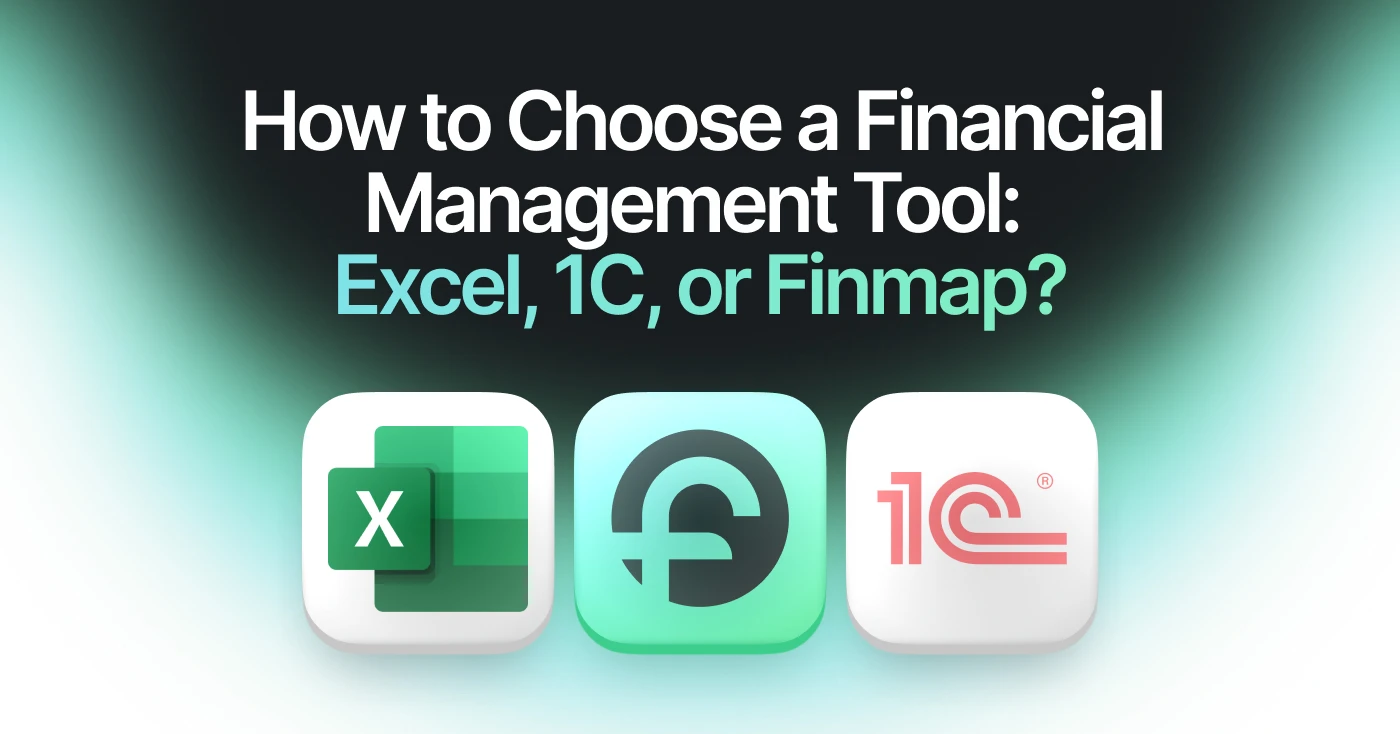
Financial Management Software: How to Choose Between Excel, 1C, and Finmap
We compare Excel, 1C, and Finmap — choose financial management software that helps you track where the money goes and automate full control over your cash flow
Do you run a business, but do you really manage its money? How much is currently in the accounts? How much will you earn in a month? Will you be able to pay salaries if a major client delays payment?
If there is no answer — the business is already playing against you. Excel with twenty tabs shows only part of the picture, and accounting reports are more like a “snapshot of the past” than the real state of affairs. Forecasting? Usually it happens intuitively, not according to a plan.
Almost every entrepreneur goes through this chaos in finances. The question is not whether there are mistakes, but how much they cost.
Today you can choose different tools: from familiar Excel spreadsheets, to 1C accounting systems, and modern online solutions. And the right choice determines how confidently you will control your business.
In this article, we will compare three of the most popular solutions:
- Excel — flexible, but manual;
- 1С — a solid system for accounting;
- Finmap — a modern alternative to Excel and a convenient online tool for financial management.
We will look at them based on key parameters that matter to a business owner:
- how much time financial management takes;
- how easy it is to work without an accountant;
- the level of automation in financial accounting and integration with banks/CRM;
- forecasting and planning capabilities;
- cost and value for the business.
After reading, you will be able to choose the best software for your business — the one that truly works for you.
Excel — a Flexible and Familiar Tool
Excel — the first step for most entrepreneurs into the world of financial accounting.Spreadsheets are simple, clear, and accessible to everyone.But as the business grows, Excel can turn from a helper into a headache.
Excel specifications:
- creating any tables and reports;
- full flexibility in structures and formulas;
- availability on every computer;
- ability to work online through the cloud.
Advantages:
- quick start without investments;
- full control over formulas and report appearance;
- flexible customization to your needs;
- free alternatives (Google Sheets).
Disadvantages:
- 100% manual work that takes hours every week;
- risk of errors and broken formulas;
- no integrations with banks or CRM;
- difficulties with teamwork;
- no forecasts or warnings about cash gaps.
Risks: loss of files, outdated data, chaos as the business grows, hidden time costs.
Best for: startups, freelancers, microbusiness. But if transactions start to pile up, it’s worth looking for an alternative to Excel.
1C — a Powerful Tool for Accounting
1C is a complete “combine” for accounting: from finances to inventory and payroll.It ensures compliance with legislation and automates a wide range of processes.
1С specifications:
- handles accounting, tax reporting, and management accounting;
- can be local or cloud-based;
- flexibly customized for the business (but with the help of a programmer);
- regularly updated to meet tax authority requirements.
Advantages:
- single database for data and documents;
- automation of financial accounting and reporting;
- powerful analytics and detailed expense tracking;
- built-in compliance with legislation.
Disadvantages:
- complexity of use without an accountant;
- high cost of licenses and support;
- slow with changes and additional integrations;
- not always a convenient tool for an owner who wants quick answers.
Best for: medium and large businesses that have an accounting team and need official reporting and advanced analytics.
Finmap — a Modern Online Tool for Business Owners
Finmap is not just another financial management software, but a dashboard that shows what’s happening with your money right now. It’s true automation of financial accounting that gives you control without unnecessary routine.
Finmap specifications:
- 24/7 online access from any device;
- integrations with banks, CRM, and payment systems;
- convenient cash flow visualization;
- forecasting of cash movements and alerts about possible cash gaps;
- a simple interface for the entrepreneur.
Advantages:
- transparency and speed in decision-making;
- automatic import of most transactions;
- teamwork without the risk of data loss;
- forecasting of future expenses and income.
Disadvantages:
- requires internet access;
- has a subscription fee, but it quickly pays off through time savings and error prevention.
Best for: small and medium business owners who need daily control, quick answers, and the ability to manage finances online.
Comparison: Excel vs 1C vs Finmap
What to Choose?
There is no universal solution — only the one that fits you right now:
- Excel — the basic option if you’re just starting out and want to simply track expenses.
- 1C — the choice for businesses with large transaction volumes and an accounting team.
- Finmap — the alternative to Excel for entrepreneurs who want transparent online financial management, automation, and confidence in tomorrow.
Choose a tool that not only sums up the past but also helps plan the future.
Because a business that sees its money ahead always wins.
Frequently Asked Questions
1. Is Excel enough for managing business finances?
Excel works well at the start: it’s free, familiar, and gives basic control. But as the number of transactions grows, the risk of errors increases, along with time spent on manual input and challenges with forecasting. At this point, it’s worth considering an alternative to Excel.
2. Why do entrepreneurs choose 1C?
1C is a powerful tool for accounting. It allows you to automate document flow, generate reports, manage payroll and taxes. It’s suitable for medium and large businesses with an accounting team. However, for daily financial control by the owner, the system may be too complex.
3. How is Finmap different from Excel and 1C?
Finmap is an online financial management tool that combines the simplicity of Excel with the automation of 1C. It automatically pulls data from banks, payment systems, and CRMs, shows real-time cash flow, and helps prevent cash gaps. It’s convenient financial automation without unnecessary bureaucracy.
4. How much do these solutions cost?
- Excel — free (or a one-time license purchase).
- 1C — an expensive system that requires spending on licenses, support, and specialists.
- Finmap — subscription-based, but it saves time and reduces the risk of errors, so it pays off.
5. What is the best software for business?
It depends on the stage:
- If you’re just starting — Excel is enough.
- If you have complex accounting and a team of accountants — 1C.
- If you need clear and simple online financial management, daily control, and forecasting — Finmap is the best solution for your business.
.webp)
Marketing Agencies Financial Management With Finmap
Discover how Finmap helps marketing agencies avoid cash gaps, control client debts, and see the real profitability of the business.
A marketing agency can grow rapidly: new clients, campaigns, budgets. But when finances are chaotic — all this growth turns into risk.
Fact: almost 50% of invoices in the marketing field are paid late. Add to this the dependence on a few large clients and the absence of P&L — and your agency becomes a hostage to others’ decisions.
In this article, you will find answers to three key questions without which it is impossible to reach a new level of financial management.
Why does an agency operate uncontrollably without cash flow forecasting?
In marketing agencies, the primary problem starts not even with clients, but internally. Incomplete or outdated reports, lack of discipline in financial management — and the owner sees the real picture only after the fact.
At that moment, there may already be no money left for salaries or payments to contractors.
Without up-to-date data, it is impossible to forecast cash flow. And without a forecast, the agency operates uncontrollably: spending more than it earns, delaying payments, and disrupting budgets.
Accurate financial management helps executives see trends and problems before they become a threat to the business. — Plymouth University
Quality data is not bureaucracy, but the key to profitability and peace of mind for the owner.
That’s why we recommend creating or choosing a single system where all financial data will be collected. Ideally, this tool should be as automated as possible: it will save time and reduce routine.
With such a system, you will be able not only to react after the fact, but also to forecast revenues and cash flow, which will open the way to stability and growth.
What a Forecasted Cash Flow Provides
- Early detection of cash gaps.
You can see when there won’t be enough money in the account to pay salaries, taxes, or contractors.
- Ability to make informed decisions.
Expanding the team, increasing advertising budgets, or entering new markets becomes safer because it’s clear whether the cash flow can handle it.
- Scenario analysis.
You can model what will happen if a client delays payment by 30 days, or how a new contract will affect overall liquidity.
- Transparent communication with the team and investors.
When clear forecasts exist, the owner can confidently justify decisions to the team and partners.
- Reduced stress for the owner.
Instead of chaotic account checks — a clear understanding of the company’s financial state tomorrow, in a month, or in a quarter.
Take a short checklist — and in a few minutes, you’ll understand whether control over cash flow in your agency is really in your hands:
If you recognized your agency in this checklist, it means the problem with cash flow planning is already affecting the profitability and stability of your business.
The next step is to understand how exactly you can bring order to your finances and get the tools for forecasting.
Key Finmap Tools for Financial Planning
If you chose Finmap as the foundation for financial management, you received more than just a convenient register of transactions. It’s a tool with bank integrations, the ability to import statements, automation through auto-rules, and delegation of responsibilities.
But most importantly — Finmap allows not only to see cash flow in real time but also to forecast it. For this, the system provides several key tools.
1. Upcoming Payments
In Finmap, you can add transactions with a future income or expense date. This turns regular record-keeping into planning: you can see in advance how account balances will change on a specific day.
This approach allows you to control liquidity and avoid situations where expenses overlap with delayed client payments.
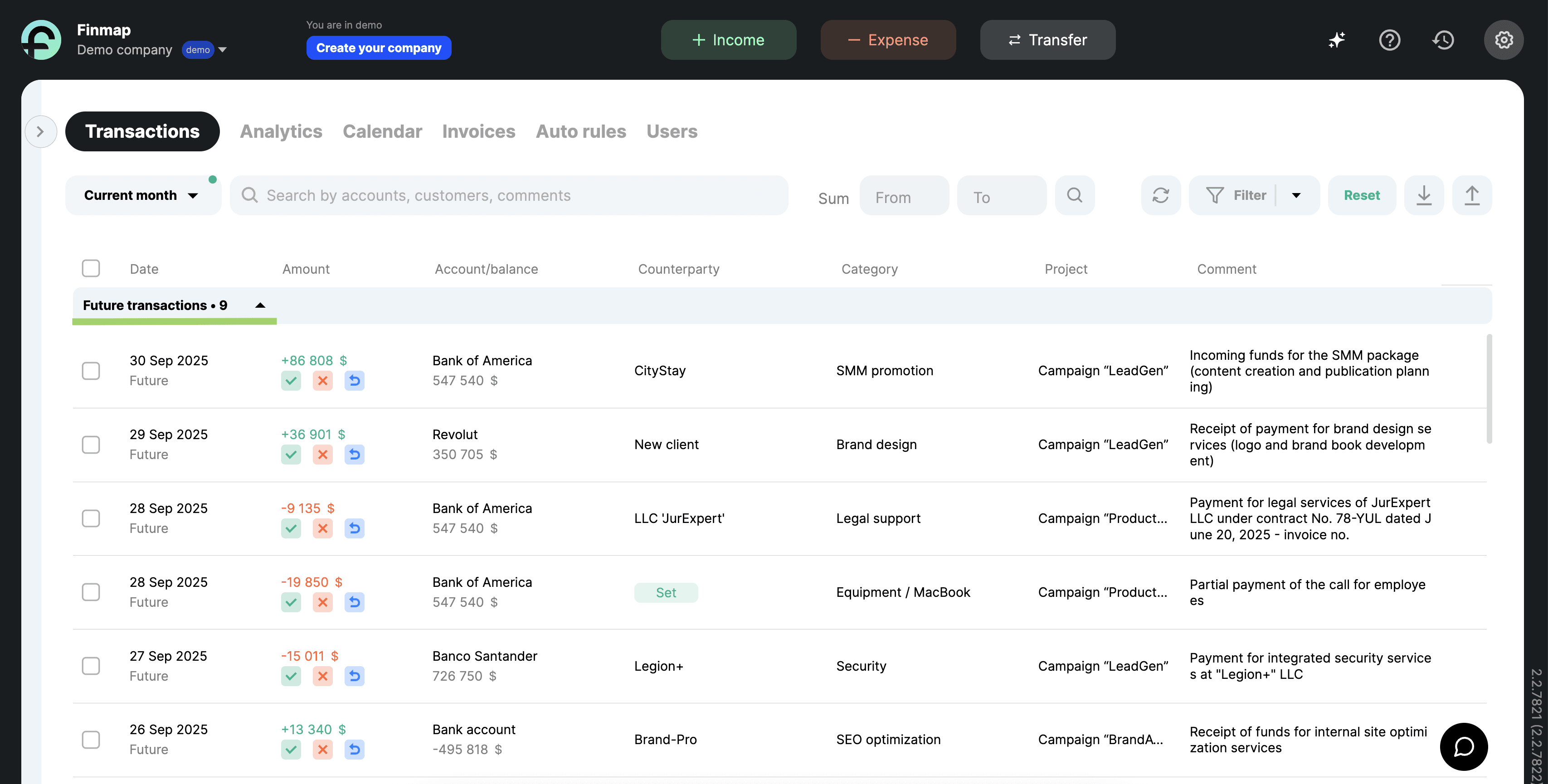
2. Payment Calendar
In Finmap, the calendar is generated automatically based on upcoming transactions. It shows when the company may face a cash gap and which specific payments are causing it.
Thanks to this, the owner can negotiate a prepayment with the client in advance, postpone internal expenses, or plan a reserve fund.
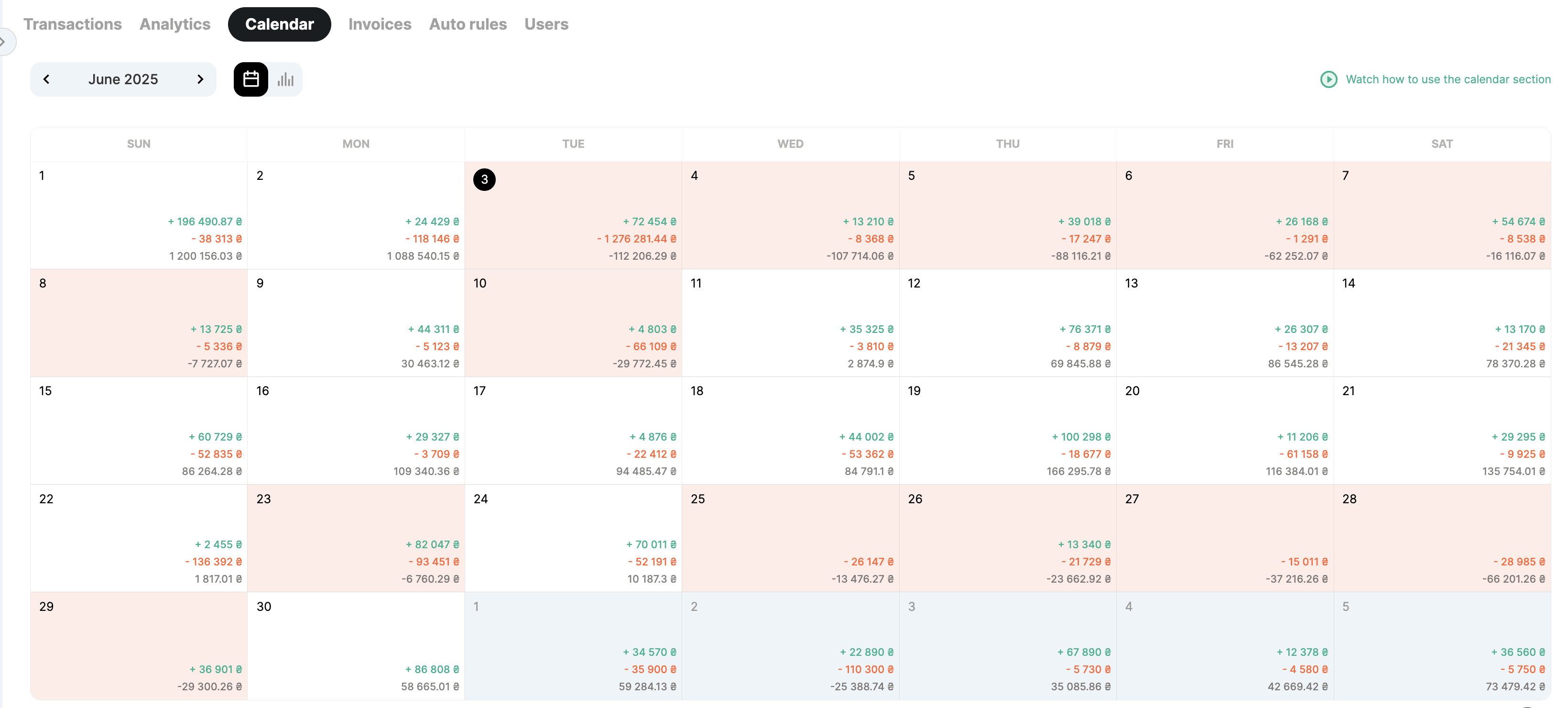
3. Toggle “Include Future / Exclude Future”
This tool allows you to view finances from two perspectives with a single click. In the “with future” mode, you see a forecast: whether there will be enough funds for salaries, contractors, and taxes if all planned transactions are executed. In the “without future” mode, you see the actual situation as of today.
It is the comparison of these two views that gives the manager key information: how far the company is deviating from the plan and where risks arise.
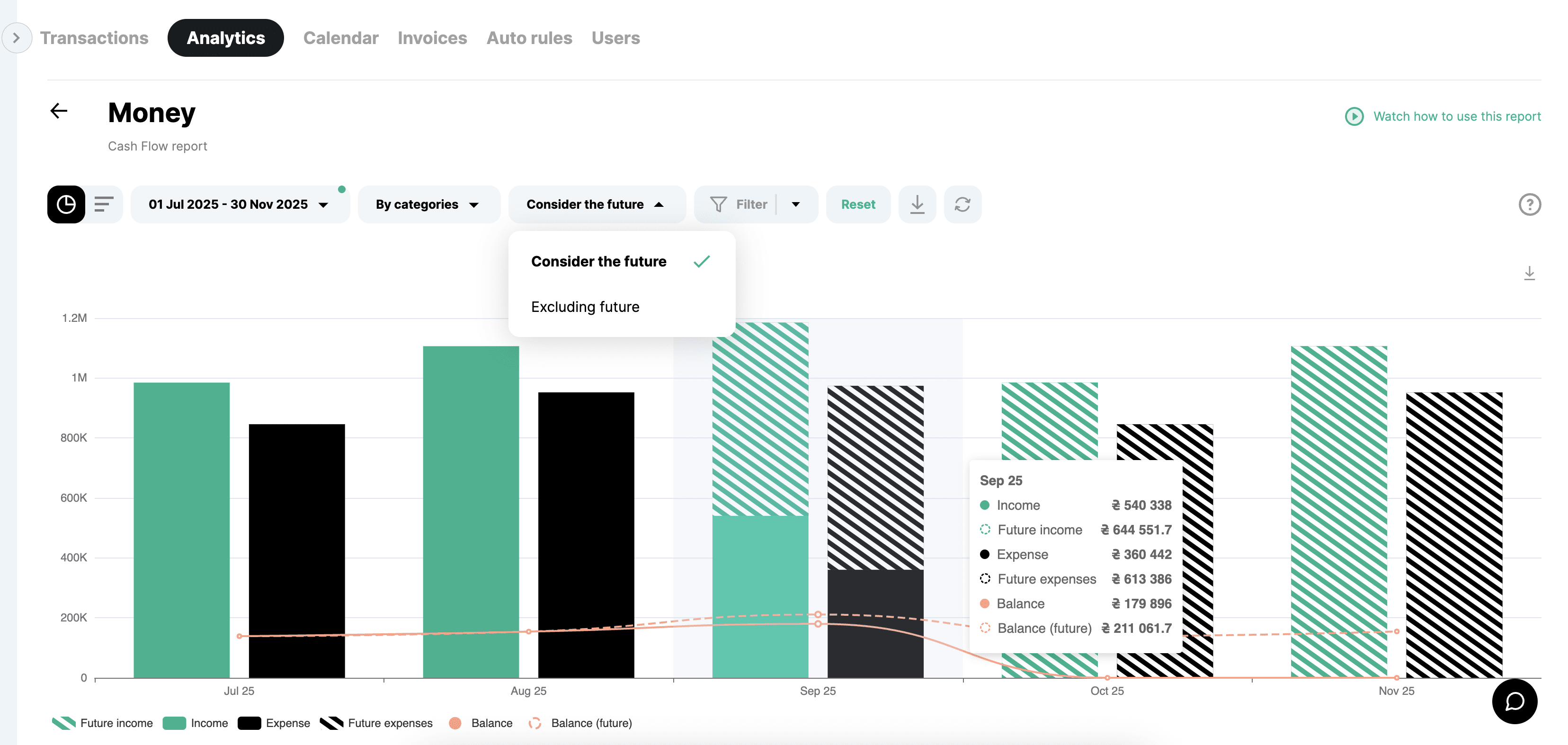
Together, these tools transform financial management from a reactive process into proactive control.
This gives a marketing agency a number of tangible advantages:
- Systematic approach instead of chaotic spreadsheets and messengers
- A single source of truth about the company’s money
- Predictability of finances weeks and months ahead
- Optimal use of team resources and time
- Clear benchmarks for financial decisions
Why is the business at risk without control over receivables and payables?
In marketing agencies, financial risks often arise not from the lack of clients, but from payment delays. The work is done, invoices are issued — but incoming funds have to be waited for weeks.
The British publication Financial IT states:
For the marketing and advertising industry, the level of overdue invoices is about 49% — that is, almost half of invoices are paid later than the established deadline.
An additional risk factor for marketing agencies is the concentration of income on a few key clients.
Studies in recent years indicate that about 15% of agencies receive more than a quarter of their income from a single client, and this is already considered a critical signal for financial stability.
Now ask yourself:
- Can you clearly name the TOP-3 clients who bring the most profit?
- Do you know which client most often delays invoice payments?
- Can you currently see the amount of debt for each client?
- Do you know which client owes your agency the most?
- Do you analyze what share of total revenue is generated by your TOP clients, and how safe this is for the business?
If you cannot answer these simple questions — it means that mutual settlements in the agency are running out of control.
And until there is a system that shows this picture in real time, your business depends on chance, discipline, and the goodwill of clients.
How Finmap Restores Control over Mutual Settlements
To ensure that mutual settlements no longer remain a “blind spot,” Finmap offers two key reports that give the agency owner transparency and real-time control.
- The Accounts Receivable report shows which clients owe money right now, how much, and which payments are still pending. This allows timely response to debts, control over client discipline, and avoidance of unexpected cash gaps.
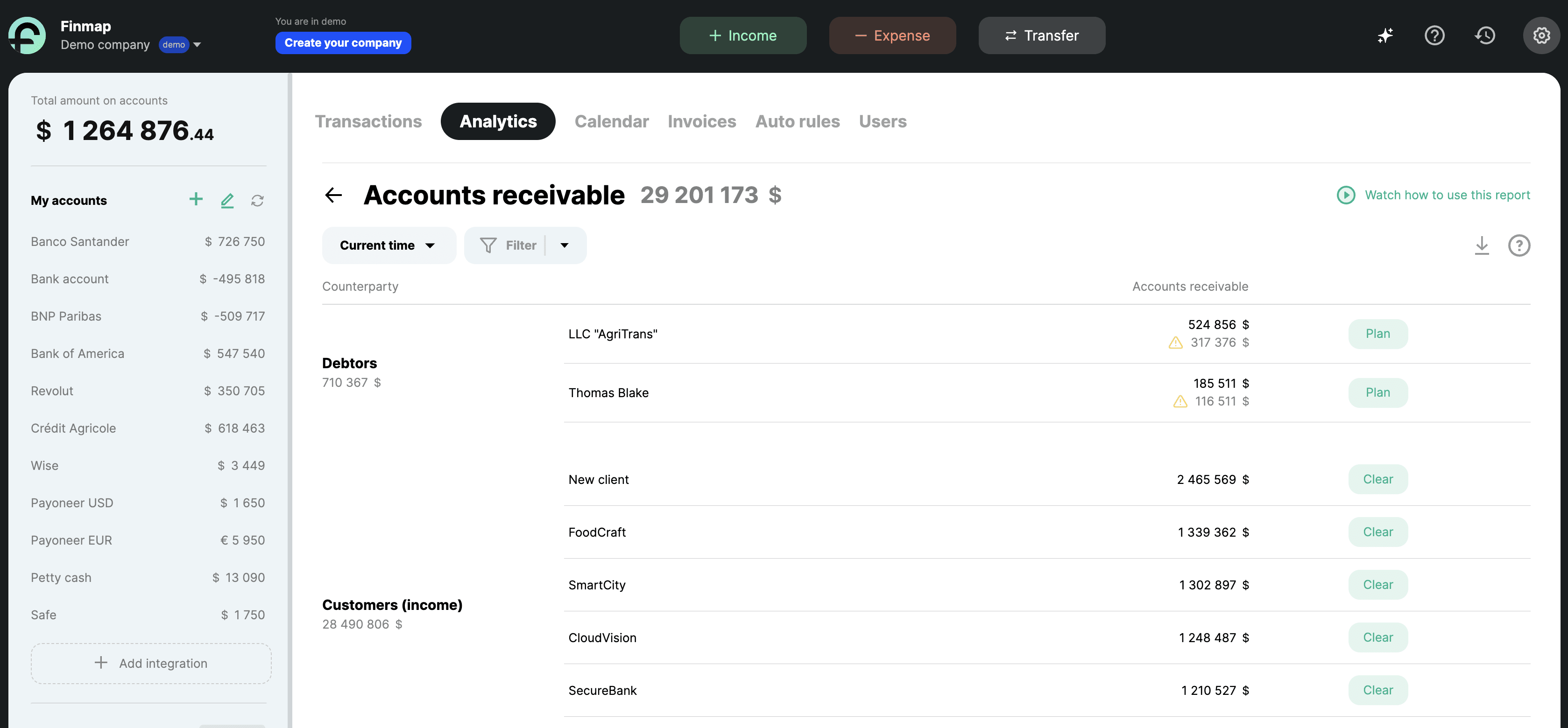
- The Accounts Payable report helps track obligations to contractors, freelancers, or services. Thanks to this, the owner understands which payments need to be prioritized and can plan expenses without the risk of disruption.
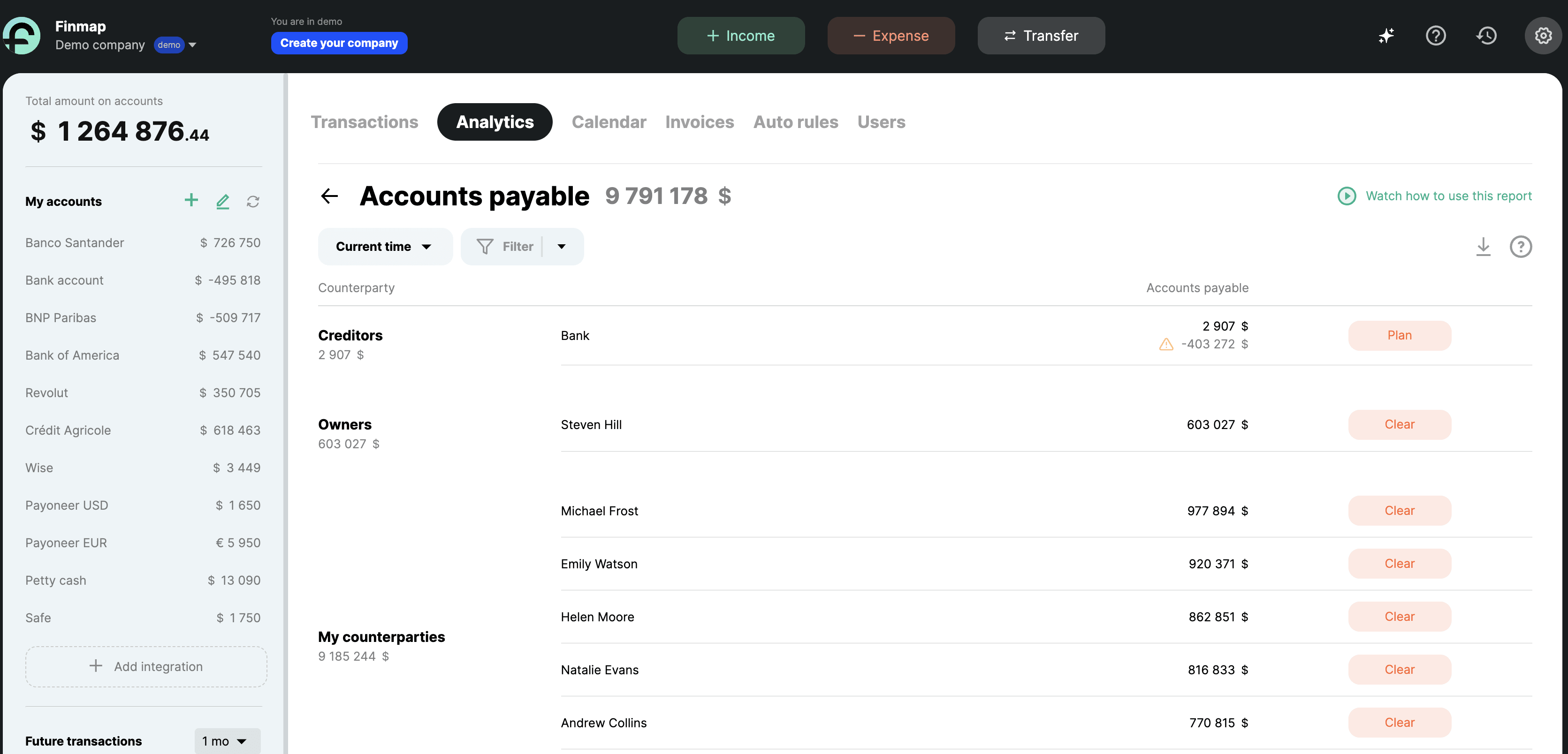
Additionally, Finmap offers analytical reports that allow you to assess profitability for each client. This makes it possible to determine which customers generate the main share of income and how dependent the business is on them. In this way, the owner can timely identify the risk of dangerous concentration and make decisions about portfolio diversification.
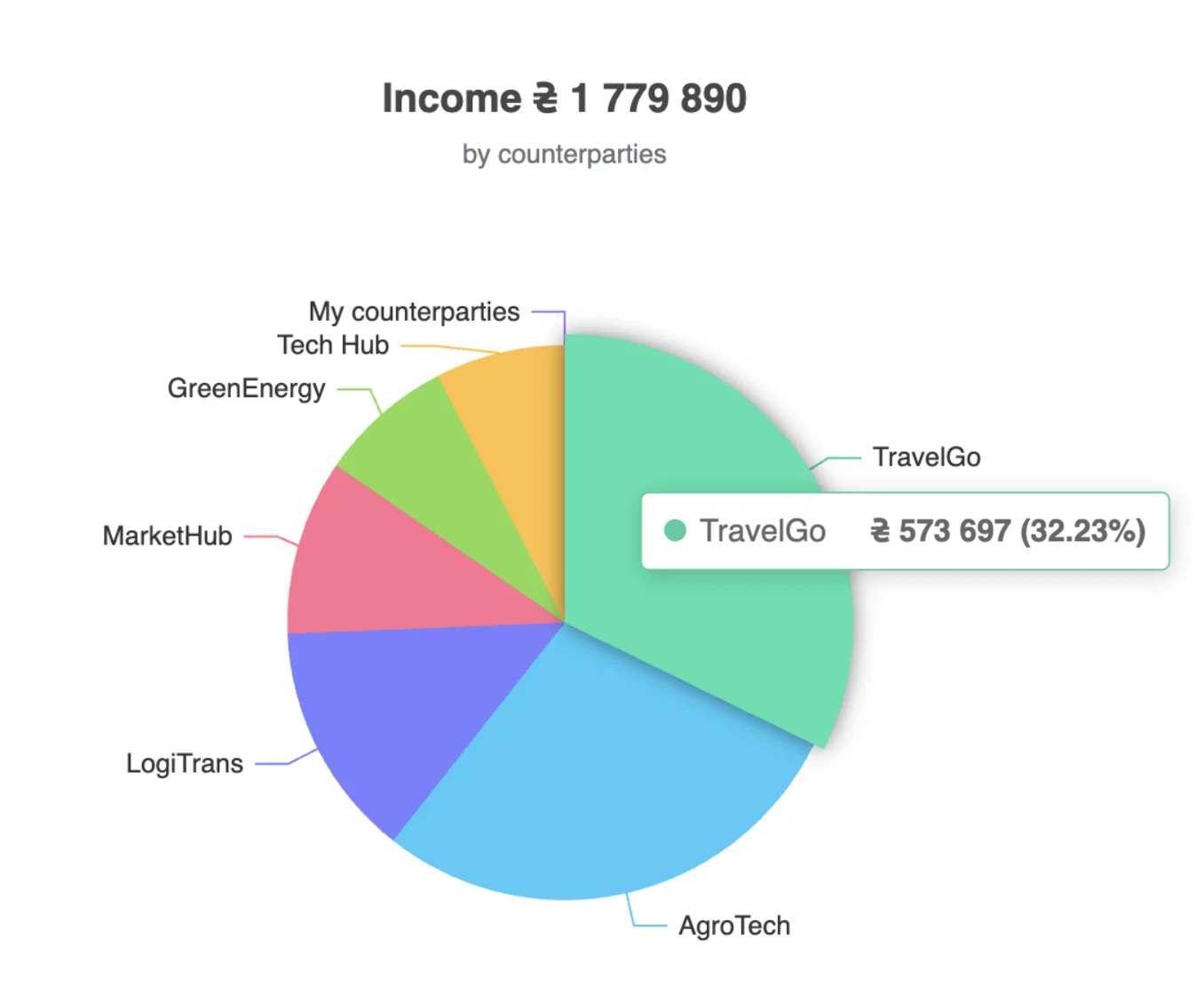
Bonus: Invoicing in Finmap
In addition to controlling receivables and payables, Finmap has another useful tool — creating invoices for clients. You can generate an invoice for your services directly in the system and, if necessary, immediately send it to the client by email.
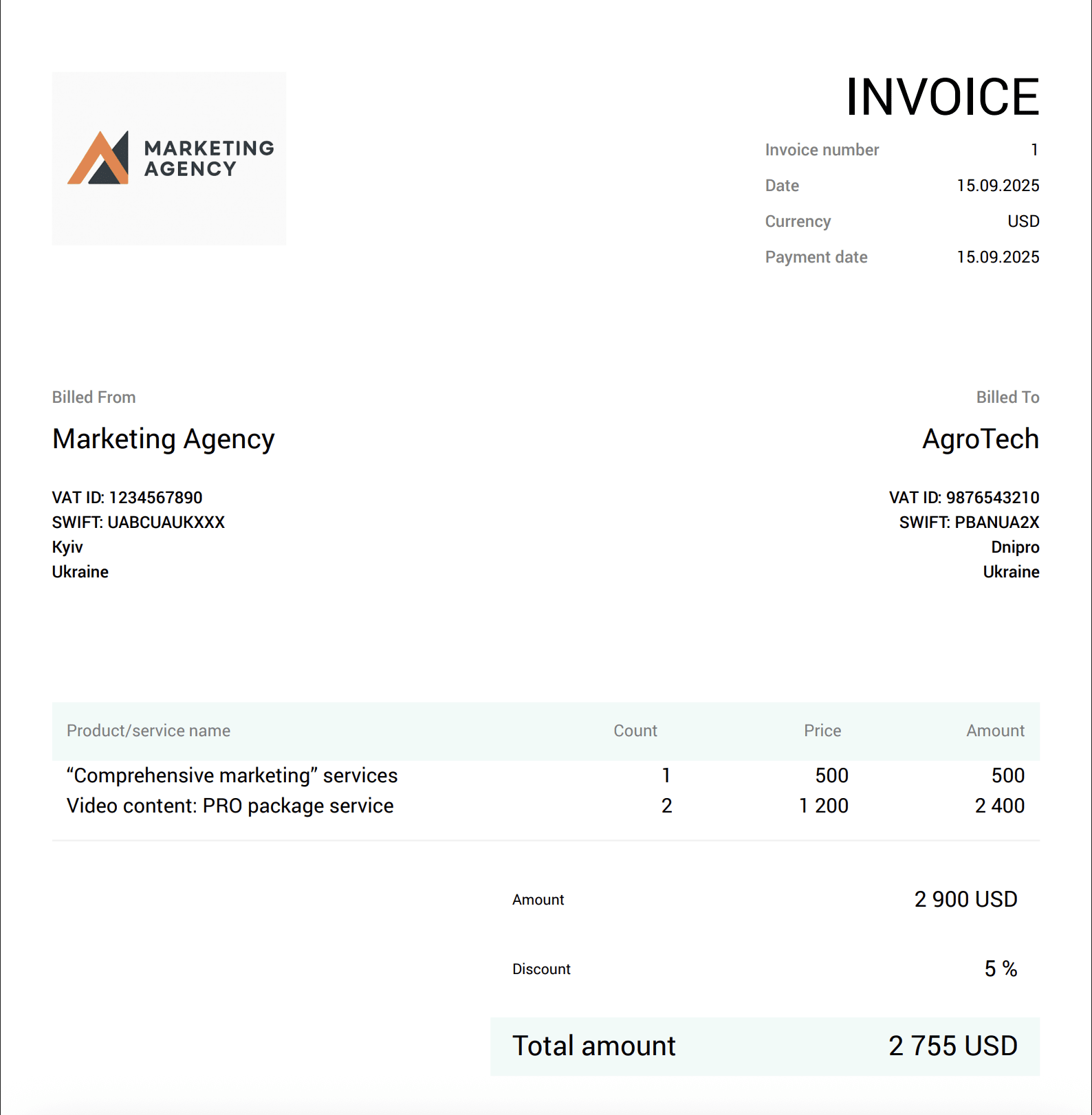
This is not the core function of financial management, but a pleasant bonus: invoices are generated quickly, in a unified style, and always remain under control within your financial system.
Why is it impossible to assess the real state of the business without P&L?
Financial management will not be complete as long as the agency owner only sees the movement of money in the accounts. The main question is not how much money came in, but how and when exactly this money was earned and what result it brought.
To move from operational control to strategic vision, a P&L — Profit and Loss statement — is needed.
It shows:
- The origin of income. Which projects, clients, or channels generated revenue, and in which period.
- The real financial result. Net profit (overall and by projects) after accounting for all expenses, not just account balances.
- The efficiency of the operating model. Whether the business generates profit or is limited to simply moving funds between accounts.
- The structure of expenses. Where the company’s main costs are concentrated — staff, contractors, marketing, or administrative expenses.
- The dynamics of development. How profitability changes month by month and whether the company is truly moving toward growth.
Cash Flow and P&L do not compete with each other — they complement one another. In the table below are practical questions that concern every agency owner and the report where you will find the answers.
Where to Find the Answers: Cash Flow or P&L?
Cash Flow shows whether there is enough money for daily obligations. P&L answers whether the business is profitable and in which direction it is developing. Only together do these two reports provide you with control in the present moment and a strategic vision for the future.
How Finmap Helps Build a Complete P&L
In Finmap, the Profit (P&L) report is generated automatically based on the company’s data. It works on the accrual method: income and expenses are attributed to the period when the contract was signed or obligations were fulfilled.
The report is flexible and multi-level. With filters, you can analyze not only the overall picture but also profitability by clients, projects, directions, or even individual campaigns.
It is also important that Profit in Finmap has several visualization formats: charts, tables, and diagrams. This allows you to look at the same figures from different perspectives — from overall dynamics to a detailed structure of expenses and income.
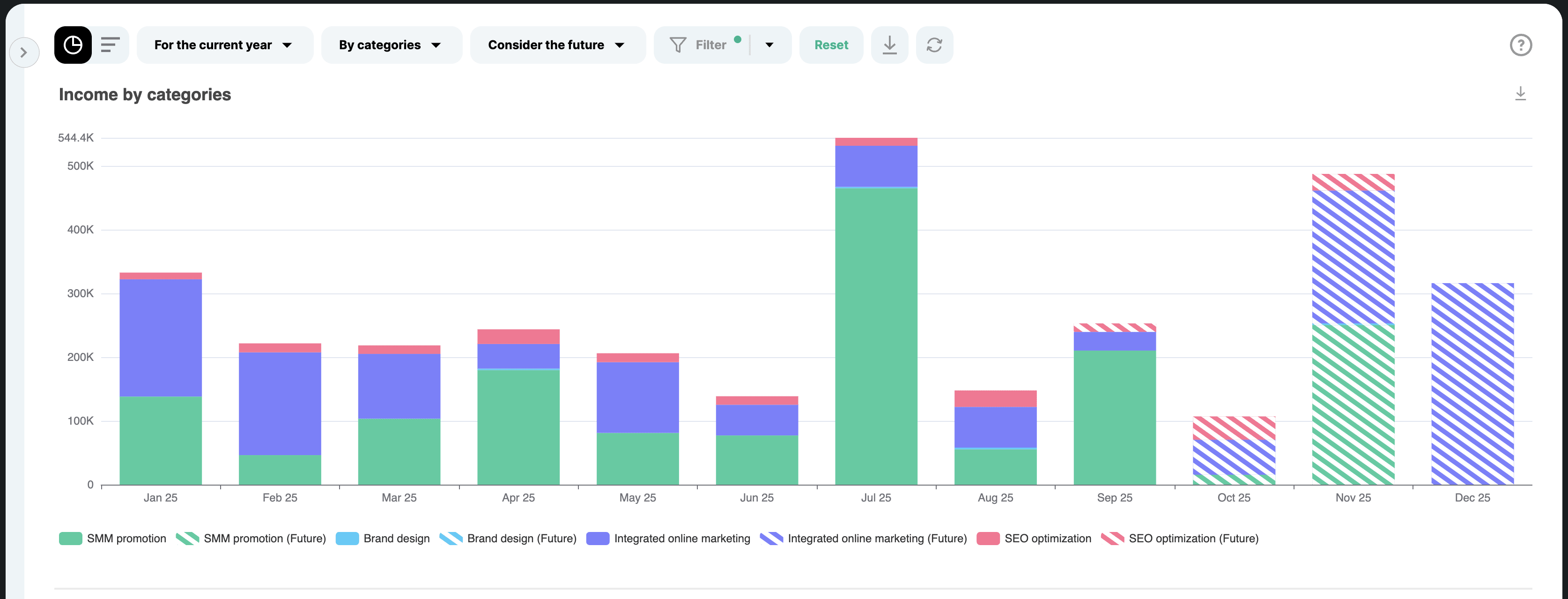
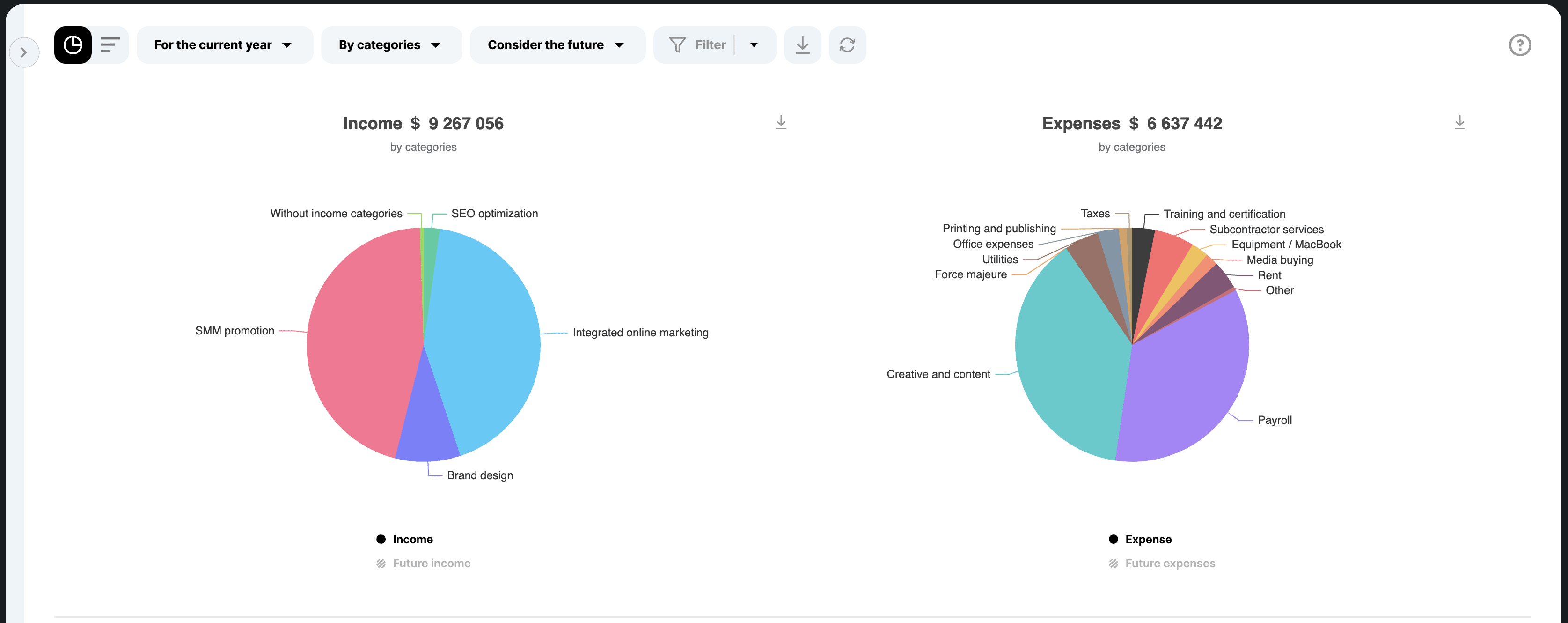
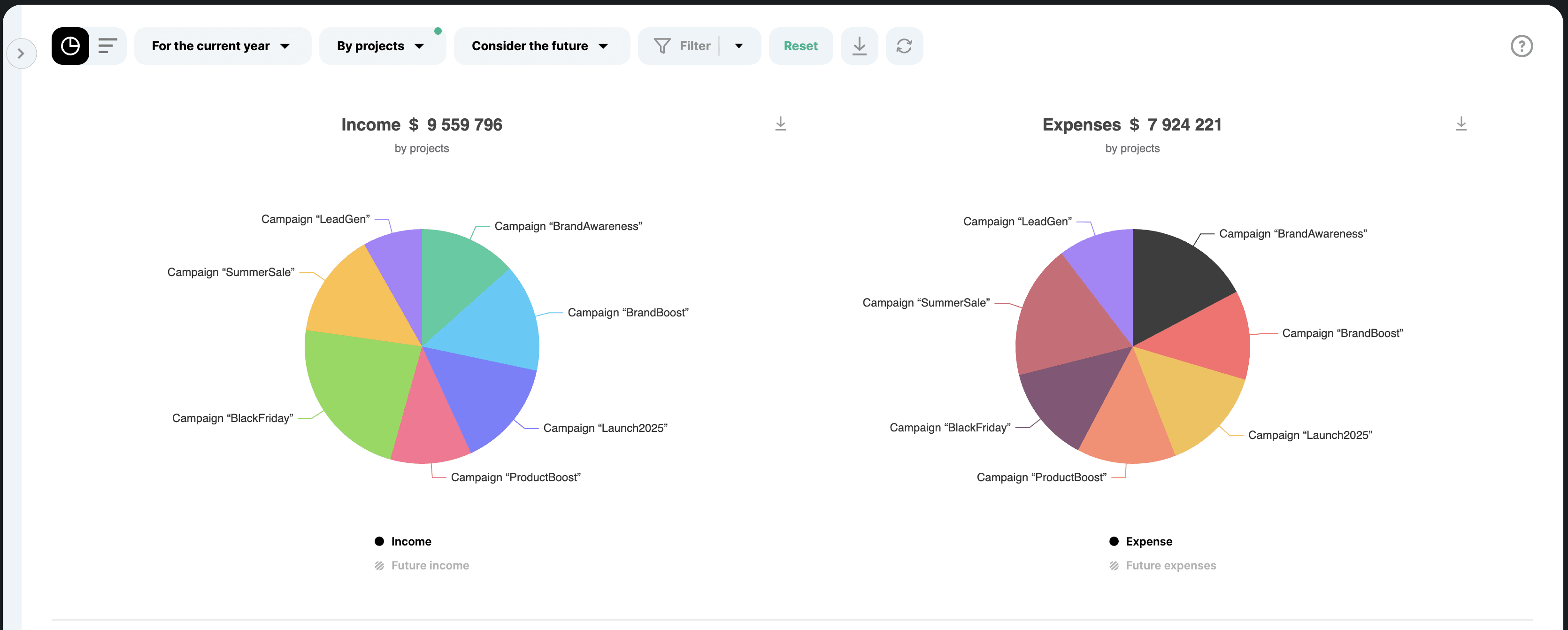
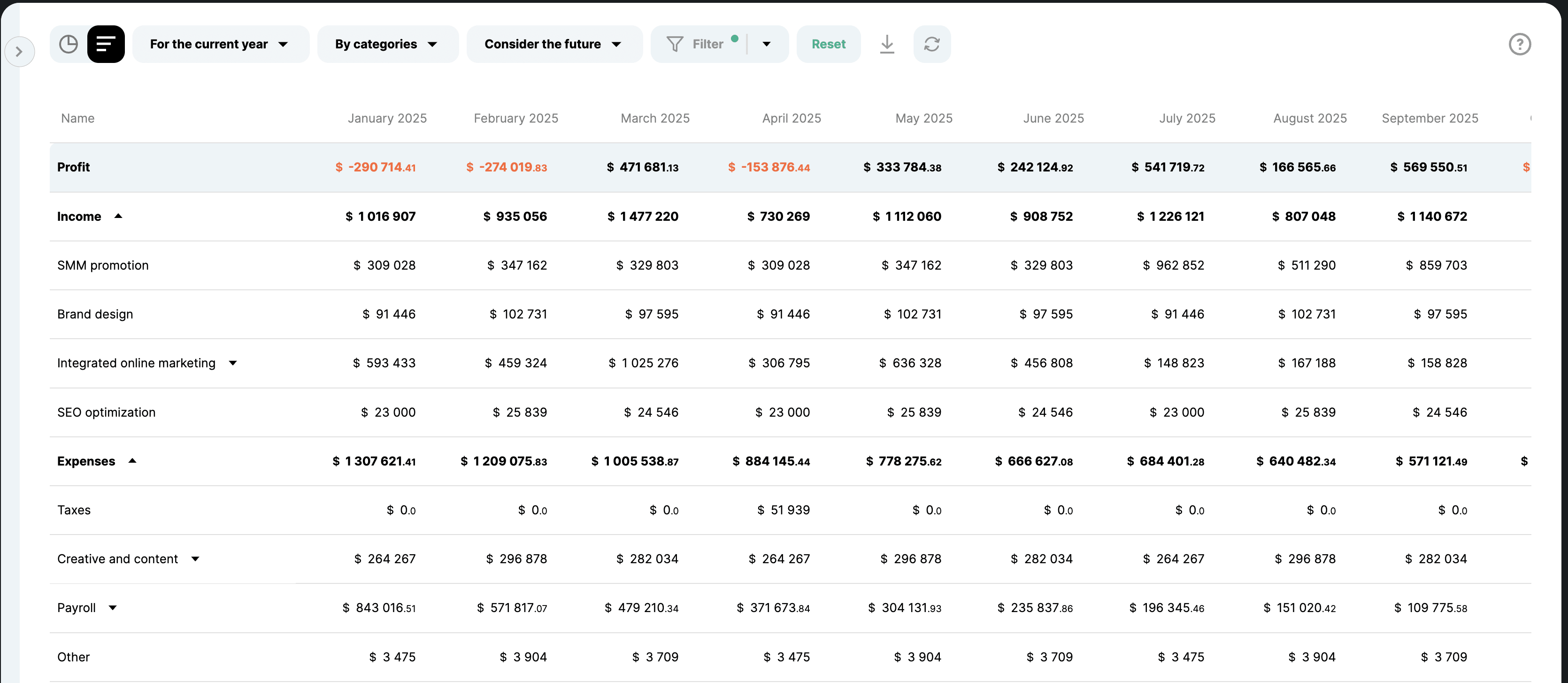
This approach reduces the errors inherent in simple cash-based accounting and provides managers with a tool for strategic decisions.
Why P&L Matters for a Marketing Agency
- Understanding true margin. In an industry with retainers and project-based payments, it becomes clear where the business earns and where resources are being spent.
- Transparency for investors and partners. It is easy to show the real financial result, not just reconcile balances.
- Scenario comparison. You can evaluate how profitability will change with a budget increase or the launch of a new client.
- Identifying hidden unprofitable clients. If payments come in regularly but expenses exceed income — this is immediately visible in the P&L.
- A basis for strategic decisions. Expanding the team, entering new markets, or optimizing expenses is based on facts and forecasts.
From Chaotic Spreadsheets to Transparent Finances: The Case of MURAHA Marketing Agency
MURAHA Marketing Agency helps businesses grow by developing marketing strategies and conducting audits. The team also manages targeted and contextual advertising, and when needed, takes on website development or involves trusted partners.
.webp)
Such a flexible model makes it possible to work with clients of different scales and collaborate with external contractors, which generates a significant volume of financial operations. At the same time, each area has its own specifics: regular monthly payments for marketing and one-time payments for website development.
Learn more about how financial management makes project-based businesses profitable.
All this creates a constant cash flow and requires a clear system of financial control.
Starting Point: Chaotic Excel
When COO Artem Tsokov joined the company and took over financial management, he inherited an Excel file where financial data was kept.
The spreadsheet turned out to be chaotic and created more problems than benefits:
- dozens of tabs without logic;
- broken formulas that distorted data;
- no systematization of expenses and income;
- delayed transaction entries;
- constant risk of losing part of the operations.
Artem quickly realized that it was impossible to manage finances this way and started looking for a tool to systematize all the data. That solution was Finmap.
A New Approach with Finmap
For Artem, switching to Finmap was not just about replacing Excel but about finding his own ideal model of financial management.
He went through several simple stages:
- Experiments with data visualization
Artem tried different ways of structuring finances multiple times — since Finmap allows you to customize accounting for specific business needs. Eventually, he defined the key financial indicators and built the system around them.
- Support from Finmap experts
Customer support played a big role: specialists helped him choose the optimal data entry model, explained how to properly work with categories, tags, and projects. This helped avoid mistakes at the very start.
- Testing different scenarios
By using the option to create several test companies, Artem was able to try out different approaches and choose the one that best suited the needs of his agency.
Transparency and Planning as a Result
The implementation of Finmap became a turning point for MURAHA Agency. If previously financial data was chaotic and unreliable, now the company has gained a transparent picture of cash flow and the ability to plan for the future.
- Automatic integrations. Thanks to integrations with banks, the risk of losing transactions or failing to record expenses on time disappeared. All payments are automatically pulled into the system, and the team can immediately check who is responsible for what.
- Systematized accounting. A convenient structure with tags, categories, and projects appeared. This made it possible to separate different areas of activity, understand which ones generate the most revenue, and which need optimization.
- P&L and Cash Flow reporting. These reports gave the agency the ability to see both actual and planned performance on a daily basis: how much money is in the accounts, which expenses and incomes are planned, and where there is a risk of a cash gap.
In addition, the company started using the payment calendar. Thanks to it, it became easier to forecast financial workloads and prepare for strategic sessions with a clear budget for the coming months.
Every day I see how much money we have now and which payments need to be made. If I see that expenses are higher than income — I can react in advance. — Artem Tsokov, COO of the agency.
As a result, the team gained not just a tool for accounting but a real foundation for growth:
- reduced risks;
- optimized time;
- tactical and strategic planning;
- confidence in financial decisions.
Advice for Other Agencies
Artem Tsokov, COO of MURAHA Marketing Agency, advises other founders and managers of marketing agencies not to waste time on chaotic Excel spreadsheets:
There’s no point in even starting to manage finances in Excel, because that’s a path to chaos. It’s better to immediately define which expenses, income, and tags you want to track, and set it up in Finmap. This way you’ll save time, avoid rework, and get a transparent picture for analysis.
His main message is simple: prepare the structure in advance and implement a modern tool right away to get results faster and avoid unnecessary mistakes.
A Financial System as the Key to Agency Growth
The key to stability and development is not the number of clients or projects, but a financial system that shows reality.
Forecasted cash flow, control over mutual settlements, and P&L — three pillars without which no agency can confidently build a strategy.
Finmap helps bring everything together:
- see the real state of finances at any moment;
- forecast future payments and avoid cash gaps;
- control client debts and payment discipline;
- analyze business profitability by clients, projects, or directions;
No more chaotic decisions — only strategic development based on facts.
Try Finmap — and see how your agency can reach a new level of financial order!
Frequently Asked Questions
- How often should financial data be updated in an agency?
It is recommended to manage finances in a mode as close to real time as possible. Even a delay of a few days in recording transactions reduces forecast accuracy and increases the risk of cash gaps.
- What is the difference between Cash Flow and P&L?
Cash Flow shows the movement of money — when and how much actually entered or left the account. P&L reflects the financial result — income and expenses in the period, regardless of the payment date.
- How to assess dependence on a single client?
You analyze the share of revenue generated by individual clients. If one client provides more than 25–30% of revenue, this creates a risk of financial instability in case the contract is lost.
- Which expenses are most often overlooked?
“Invisible” expenses include freelancers, contractors, regular subscriptions to services, and unpaid client hours of the team. They often reduce real margin, even when revenue is growing.
- How to avoid cash gaps in a marketing agency?
The basis is planning. It is necessary to forecast future inflows and outflows, use the Payment Calendar, and control accounts receivable. If cash gaps occur frequently, it is recommended to have a reserve fund to cover at least 1–2 months of operating expenses.

Launching a New Project: How Finmap Builds Financial Models for a Successful Market Entry
How Finmap helps entrepreneurs create financial models for the successful launch of new projects and effective international expansion based on the EMMER case study.
Launching a new project or taking a business to the next level is always a challenge for an entrepreneur. Not only the success of the launch, but also the long-term stability of the company depends on competent financial planning.
How to effectively allocate resources at the startup stage? What costs should be taken into account to avoid financial difficulties in the future? How to create a financial model that will become a roadmap for your business?
These and many other questions will be answered by EMMER's case study, which demonstrates the importance of creating a financial model that becomes the basis for successful market entry.
Meet EMMER, a sliding kitchen for Jeep Wrangler JL
For the modern explorer, the journey is as important as the destination.
EMMER is an innovative retractable kitchen designed for owners of Jeep Wrangler JL adventure vehicles. The design combines advanced technology with striking aesthetics, while enhancing the enjoyment of impeccable outdoor cooking.

Challenges and financial calculations: How to successfully launch a business project in the US market
EMMER is a business project that will be launched from scratch in the US market. This is a new experience for the owner, but he has a golden rule:
First, you have to win the calculations.
Before launching any project, an entrepreneur should carefully evaluate all costs and potential revenues. Even if the project seems very attractive, it is important to determine whether it makes sense from a financial point of view. The key is to understand the conditions under which the business will be profitable, or at least not cause losses.
The task was to clearly define the conditions for the success of the business project, taking into account the required sales volume and the price of the product. To do this, several key parameters had to be taken into account, including launching the project on the Kickstarter platform. This platform allows you to raise pre-funding from potential buyers, spend time making the product, and send it to users. However, the implementation process has many nuances that need to be taken into account to achieve success.
Project features: Why the financial model is key to success on Kickstarter
Launching a company on Kickstarter requires not only a presence on the platform, but also careful preparation. One of the key stages is the pre-launch campaign, which lays the foundation for future success. Preparatory activities include collecting a database of potential customer email addresses and creating an active community around the product. All these actions require significant investments.
The main costs are worth highlighting:
- Organizing a PR campaign.
- Presentation of the product through influencers, which requires the production of the product, its shipment to the United States, and payment for the services of influencers.
- Hiring an agency to professionally launch a Kickstarter campaign.
In addition, you need to consider the following costs:
- Kickstarter commission.
- Acquiring fees.
- Taxes in the country of production.
- Customs clearance costs in the United States.
- Payment for the work of the team that will implement the project.
Success on Kickstarter is determined by how carefully these costs are planned. Only a well-calculated financial model will allow you to not only cover all expenses but also ensure the profitability of the campaign. It's not just about preparing a budget, it's about strategic planning that lays the foundation for scaling your business.
EMMER needed effective solutions to overcome a number of challenges and to grow successfully:
- Project development: The need to improve the current project to take it to the next level required the development of new approaches and strategies to ensure competitiveness and sustainable growth.
- International expansion: Expansion into international markets required adaptation to different market conditions.
- Financial planning: The need to create a financial model that will allow to estimate the profitability of the business, determine the required volume of sales and services. The financial model should help to understand what factors affect profitability and how to optimize them to achieve financial goals.
Financial planning and analysis with Finmap: how to optimize costs and maximize profits
The most effective way to analyze all expenses and profits is to build a financial model with the help of Finmap specialists, as there are many parameters to consider.
The owner of EMMER knew that Finmap was not just a program for accounting for money, but also a team of professional financiers offering expert services for creating and developing projects.
It was also known that Finmap helps both new startups and existing businesses reach a new level.
What is a financial model and what role does it play in the decision-making process?
A financial model is a tool used to forecast the financial performance of a business. It is a mathematical representation of the financial aspects of a company, including revenues, expenses, profits, cash flows, investments, and other financial indicators. The model allows you to analyze the current financial situation and forecast future results based on various scenarios, such as changes in costs, pricing, market environment, etc.
Financial models are widely used for business planning, investment project evaluation, management decision-making, and strategic planning. They can be developed for companies of any size and in any industry, and can be used to assess risks and opportunities.
The process of creating a financial model begins with an in-depth analysis of your business. Finmap experts collect detailed information about the project, which allows us to accurately calculate financial flows and forecast future income.
What Finmap specialists take into account:
Vitrate structure:
- Product costs (cost price and logistics).
- Operating expenses (salaries, development costs, prototypes).
- Payment system fees, legal and unforeseen expenses.
Marketing and sales:
- The cost of a marketing manager's salary.
- Marketing budget (typically 30% of the planned Kickstarter collection).
- Content and PR costs.
These costs form the basis for calculating EBITDA, taxes, and the final net profit. The financial model also takes into account different pricing strategies. For example, Kickstarter often offers significant discounts to attract early adopters, while it is important to maintain margins for subsequent sales through dealers.
The main purpose of the financial model is to help determine and achieve the optimal amount to collect. It's important to set a realistic goal that can be exceeded rather than risking too much. For example, Kickstarter campaigns usually last two months and raise between $100 thousand and $150 thousand, but it is better to set a goal, for example, $80 thousand, which can be exceeded.
The financial model also allows entrepreneurs to experiment with different combinations of prices and sales volumes, such as retail price, dealer price, early bird price. This helps to understand how changes in strategy affect the overall business picture and how much money can be raised on the platform.
It's important to take into account all expenses, including pre-launch campaign costs, to assess the realism of the goals. For example, if you raised $130k but spent $108k on it, will you be able to sell enough products in a month to be in the black?
A financial model is a forecasting tool. It helps to plan sales for the whole year so that the company remains profitable. Working with the model, you can assess the impact of various scenarios, such as selling only through dealers or only at retail, and understand how this will affect the business.
You also need to take into account the tax jurisdiction: in Ukraine, the tax can be 5%, and in Europe, it can be up to 40%. The financial model shows under what conditions the business will be profitable or risk becoming unprofitable.

A financial model allows an entrepreneur to clearly understand what expenses and income to expect and how different strategies will affect the financial result. It helps to optimize costs, find variables that can be adjusted, and make informed decisions that will ensure business profitability.
Results of cooperation: Financial models for optimization and global growth
Finmap's financial modeling service has been a key factor in EMMER's success.
What has EMMER gained from working with Finmap?
- A structured financial model: Professional financiers have developed a customized model for the company, which provided a clear understanding of the possibilities for increasing profits. All data is displayed in clear tables that take into account many parameters, which allows for effective management decisions. This has helped optimize finances and increase the efficiency of management processes, which will allow the company to successfully develop and launch new projects.
- Optimization of financial flows: Automated cash flow tracking will reduce costs and increase profitability. In addition, detailed data analysis will allow for better cash flow forecasting and budgeting, which has significantly increased financial stability.
- International Expansion: With Finmap's support, the brand will not only be able to successfully expand its operations to new international markets, but also ensure transparency and efficiency of financial processes at all stages of projects. Finmap's support includes detailed cost and revenue analysis, development of financial models that meet the requirements of new markets, and assistance in optimizing financial strategies. This includes budget planning, cash flow management, investment planning, and strategic financial management to achieve sustainable growth and profitability on a global scale.
Whether you're planning to launch new projects or looking to improve the financial performance of your existing business, creating a financial model is a critical step.
Use Finmap to successfully implement and realize your projects.
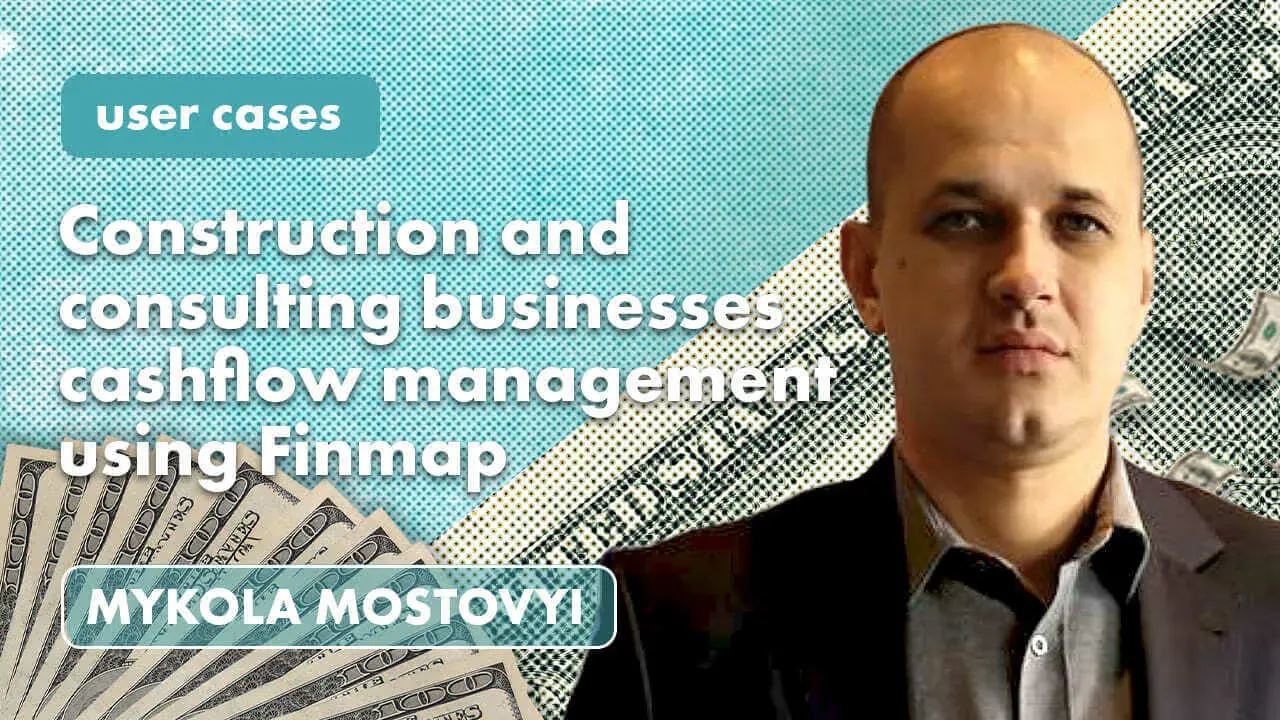
How a Construction Company Grew by 150% in One Year, Even During the Pandemic, with Strong Financial Management
Intelligent System, Warsaw – Nikolaj’s consultancy company that helps entrepreneurs with strategic planning, creation of financial models, pricing, marketing and everything else a business needs to grow.
.webp)
User case card
Mykola Mostovoy – 16 years entrepreneurial experience, 3 years doing business in Poland.
He is engaged in construction, retail and provision of services.
Certified financier.
Loves to help other entrepreneurs become more efficient and orderly with money.
Intelligent System, Warsaw – Mykola's consultancy company that helps entrepreneurs with strategic planning, creation of financial models, pricing, marketing and everything else a business needs to grow. They also help companies from Ukraine to enter the Polish market.
Website: https://intelligentsystem.com.pl
Given
Before setting up a consultancy company, Mykola was in the construction business. His projects were growing, with 10 crews plus managers who ran the sites.
Each of them had separate budgets for the purchase of materials and consumables. It all had to somehow come together in one place in order for Mykola to understand:
- how much money was taken from the customer;
- how much was spent on procurement and salaries;
- whether each project was paying for itself;
- if his inventory was accounted for.
Plus, Mykola wanted to see his daily cash flow, track profits, and identify areas of loss.
In other words, there was a need for systematic management accounting in Mykola's business, so he began looking for solutions.
Task
Can such important information be entrusted simply to an accountant? In Poland, outsourced accounting companies only do bookkeeping and tax reporting. But the main disadvantage is they submit the previous month’s data until the following month. In other words, you have to wait 2-3 weeks for a report in order to understand the situation in the business.
We required a more timely management accounting tool that would show us where we are earning profit, where we are losing money, and where we could operate more efficiently. — Mykola Mostovyi, founder of the Intelligent System
Another option was to hire a financial director. However, in Warsaw, the salary of such a specialist starts at 8,000 PLN (about 2,000 €) a month.
Finmap could implement management accounting at a much lower cost. Mykola identified the following objectives:
- Find a simple solution so that even someone without an accounting or economics background could use the system, and project managers, foremen, or drivers could deal with procurements.
- Keep all the management accounting in one place.
Previously, Mykola used a Polish accounting service. However, they could only cover a single task. For example, drawing up estimates, reporting cash inflows and outflows, or profit and loss (P&L report). Everything was in Excel, which was difficult to use and took too much time. In addition, there was not enough capacity to solve all the tasks.
- It was imperative that the service had a payment calendar.
Mykola wanted to plan finances for the month ahead and beyond, and also anticipate cash gaps in order to avoid them.
- Select a multilingual solution.
The team includes people from Ukraine, Moldova, Georgia, Belarus and Poland. So, Polish services alone were not suitable, since not all employees know Polish. Therefore, he needed a service where he could choose from a variety of languages.
Finmap solution
Looking for a suitable option, Mykola came across the Finmap website and registered to give it a try.
First step
To begin with, as a certified financier, he turned to his financial model. He organized his income and cost structure. He systematized the information about where his business money was, which departments and team members had it, and which clients owed it. Than he transferred all the information to Finmap.
Mykola gave access to project managers, foremen and the drivers who make the purchases, because Finmap has the ability to restrict access and select which information an employee can add, which can only be viewed, and which is available only to the company owner.

After that, all transactions were added through 3 simple buttons: Income, Expense and Transfer. System accounting had started.

Stop losing money
It was not uncommon in Mykola's construction business for employees to lose receipts after purchasing materials or consumables. As a result, customers would not reimburse these costs and the company had to bear them. Thousands of euros were lost in this way.
There was a situation in September when an employee lost an invoice for 4,500 PLN (about 1,000 €) and simply forgot it. When we submitted the documents to the accountants for settlement, it turned out that the invoice was missing. Consequently, we wouldn’t have calculated the 4500 and we would have lost the money. It’s a good thing he ran it all by Finmap. — Mykola Mostovyi, founder of the Intelligent System
Seeing on the report that there has been such an expense, you can simply go to the shop and recover the receipt to provide to the customer. Mykola points out that they would have lost more than the cost of their Finmap subscription with these situations alone.
Important reports
As one of Mykola’s tasks was to control cash flow on a daily basis, he regularly analyzes the Cash flow report*.

* The Cash Flow report in Finmap shows cash flow and allows you to see which amounts are being received and which are being spent by the company.
The Payment Calendar* has also proven to be very useful. Thanks to it, the risk of a cash gap is now visible in advance and there is time to correct the situation. In general, it is very convenient to plan all payments in advance. It helps to budget for the next month and beyond to predict the future of the business.

* In the Finmap Payment Calendar, you can see balances and money movements for any date. This includes payments planned for the future. If you add future expenses or receipts, the Payment Calendar will show whether there is enough money or if there is a risk of a cash gap.
Force majeure
From time to time, there have been some force majeure, or unforeseeable situations. Someone with ownership status* accidentally deleted the company’s Finmap profile. A huge amount of data seemed to have been lost. Mykola quickly contacted the customer support service and our managers pulled the archive with the vital information from the cloud. Everything except the transactions from the last 2-3 days before the deletion was saved there. These were retrieved and the records were restored.
* No one on the Finmap team has access to our users’ data. Therefore, there is no risk that any of the managers could delete the company or any of the data.
The result is
- Mykola now has systematic financial accounting for several companies.
- It is easy to keep track of cash turnover. Thanks to Finmap’s simplicity, Mykola has quietly delegated this task to project managers and a driver who handles purchasing and delivery of goods. The employees enter all the transactions themselves and thus save a lot of time for the owner and managers.
- The payment Сalendar helps to avoid cash gaps. The service warns of the possibility of a shortage of money and Mykola can plan in advance how to raise additional funds.
The payment calendar helped us to plan our income and expenditure so that we knew whether we had a cash gap or where it might occur. We had time to react and avoid such a situation. — Mykola Mostovyi, founder of the Intelligent System
- In addition, thanks to the payment Сalendar, the owner always knows to whom, when and how much his or her business owes, and who owes how much to them. It helps to plan the budget for the month ahead and beyond.
- Mykola’s business does not now lose money due to mishandled receipts. Even if a receipt is lost after purchasing materials for a client’s site, the amount spent has already been entered into Finmap. This means it will not be forgotten and can be easily confirmed to the customer by simply restoring the receipt.
In addition, customers like this kind of systematic accounting. They can see how much was spent on their project and where exactly the money went. This adds credibility to the company.
- Businesses save money on the services of a CFO:
At the level where we operate, we should have hired someone to handle the finances a long time ago. But with the Finmap service there is no need for that yet. — Mykola Mostovyi, founder of the Intelligent System
- One of Mykola’s companies, which has implemented Finmap for fintech, has grown by 400% in one year. And last year, even despite the pandemic, there was ~150% growth.
In particular it is a credit to Finmap, because even in difficult times we understood how much money we had, what we could count on, what we could buy and so on.
P.S.
– Why did you decide to implement Finmap in your business?
– Because it is cool! — Mykola Mostovyi, founder of the Intelligent System
And to find out more about Intelligent System’s consultancy services, click here: https://intelligentsystem.com.pl

